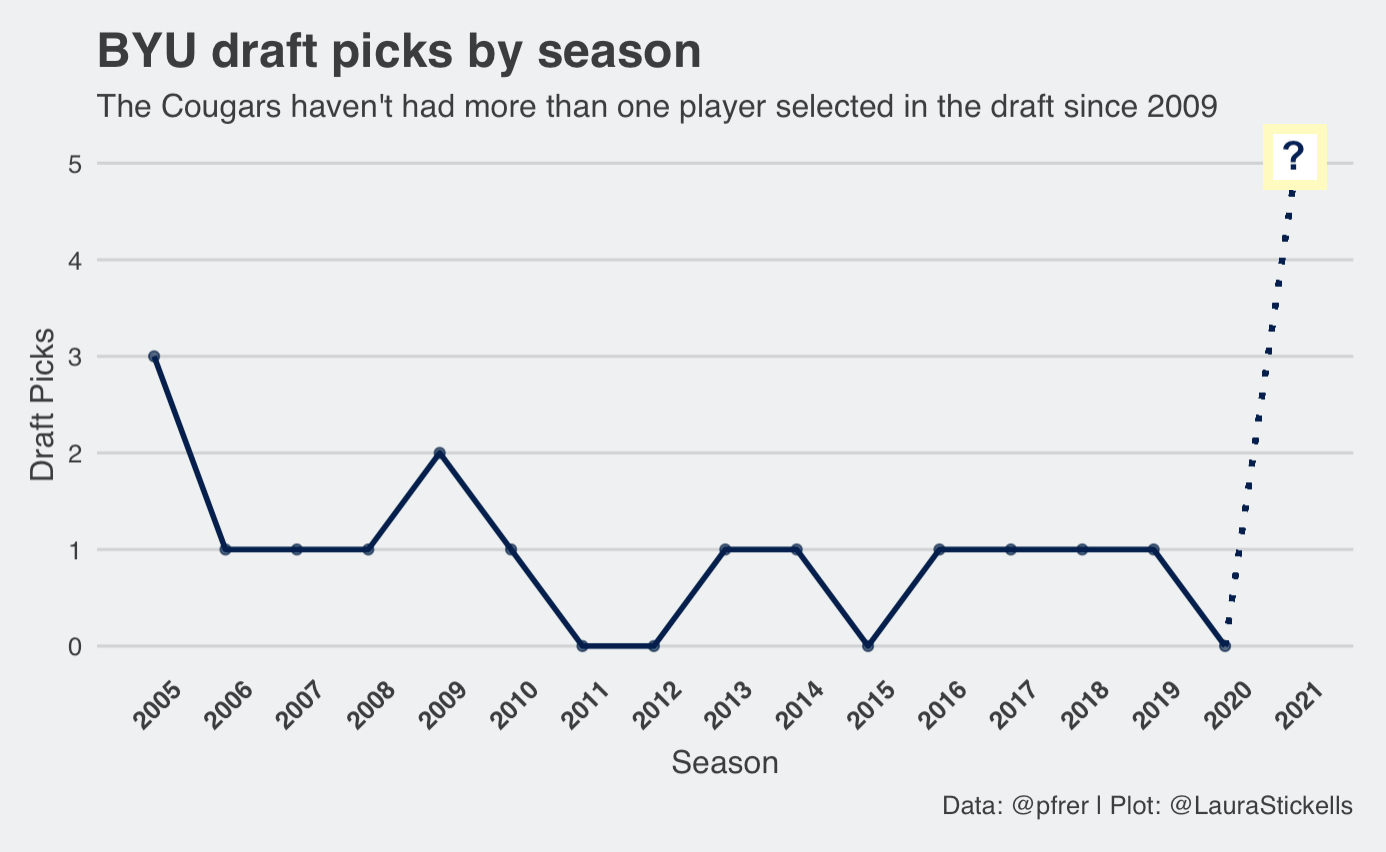This BYU draft class is *literally* off the charts
By Laura Stickells | April 28, 2021
Zach Wilson is stealing the show at BYU, but his supporting
cast of draft eligible Cougars is literally off the charts. (Yes literally! Look
at the graph!)
Only seven BYU players have been selected in the draft since
2010, but over the next three days, that number could practically double. Pro
Football Focus included eight Cougars in its top
300 draft board, and although a few of those will likely fall to free
agency, five picks feels like a practical possibility.

But how did such a talented group of guys end up in Provo,
Utah? According to Jeff
Hansen, who has covered BYU for the past 10 seasons, we’re finally starting
to see the impact of a recruiting strategy shift that took place five years
ago.
BYU’s affiliation with The Church of Jesus Christ of
Latter-day Saints dramatically limits recruiting opportunities, so when head
coach Kalani Sitake took over the program in December of 2015, he knew he had
to get creative.
“Most football coaches, they want to go and get the best
football players that they can find. But when Sitake took over, he knew that
BYU couldn't compete with the big schools,” Hansen said over the phone. “Sitake
just wanted to get the best players who were good at something, whether that's
somebody who has crazy good size, or somebody who is super fast.”
“Then he trusted his and his coaching staff's ability to
develop whatever that something was into a really good football player,” Hansen
added.
Hansen pointed to Brady Christensen as the epitome
of the philosophy. When Christensen graduated from high school in 2015, he
was a two-star recruit, weighed only 245 pounds and was playing centerfield for
his high school’s baseball team. He did not look like a typical lineman. But he
was fast and, according to Hansen, “freaky athletic.”
This year Christensen became the Cougars first consensus All-American
since 2009 and is projected to go late in the third or early in the fourth
round. He’s also 55 pounds heavier.
Wide receiver Dax
Milne, another two-star recruit who came to BYU as a preferred walk-on and a talented route-runner, is
another prime example.
“If you just saw Dax Milne on the street, he just looks like
a guy,” Hansen said. “He's like 6 feet tall, 175 pounds, and just kind of a
skinny dude. Even now that he's getting ready to go to the NFL, when you look
at him, he just looks like some average guy. But he's special.”
Some draft boards put
Milne in the third round, while others have him getting picked up in free agency.
If BYU’s history in the NFL is an indication for the future,
Milne, Christensen and the other draft eligible Cougars have a good chance of
success. Although only seven players from BYU have been selected since 2010,
the majority have performed well. Of the 112 schools that had five or more
players selected since 2010, the group from Provo ranks second in average Career Approximate
Value.
And looking at those seven players individually, many have
outperformed their draft position.
Most notably, Fred
Warner, who was selected in the third round by the San Francisco 49ers in
2018, has accumulated a Career AV significantly greater than all the outside
linebackers selected before him.
Sione Takitaki,
Jamaal
Williams and Kyle Van
Noy (all picked after the first round) each have performed on par with the earlier
draft picks at their respective positions, which, if you think about it, is an
overachievement. If draft position is predictive of NFL success, the
expectation would be that the last drafted player performs well below that
average.
Additionally, undrafted free agents Taysom
Hill and Daniel
Sorenson have both had successful pro careers.
This consistent overperformance, Hansen thinks, could be a
product of age, as many BYU athletes serve a mission for two years before starting
college.
“When guys go on missions and then come home and play for
four or five years in college, by the time they go to the NFL they're just old,”
he said. “I think the NFL doesn't want to try to develop somebody who's already
25 or 26 years old. And a lot of BYU players are that age. But when they get a
chance in the NFL, they stick and they do pretty well.”